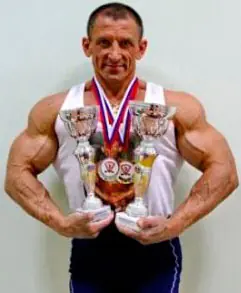Powerlifting and bodybuilding in Russia in the era of the dashing 90s
By the end of the 20th century, bodybuilding in Russia in particular, as well as in the World as a whole, had already acquired very specific outlines organized, collective, international movement. Its rapid development continued, increasing its momentum even more. The number of supporters of this sporting movement has continuously grown and continues to grow exponentially, and the victories achieved by former Champions become example and example for new athletes around the world...
The performance of the Russian team (1991) can be considered truly a sensation at the men's world powerlifting championship, which ended in the Swedish city of Örebro. For the first time, 26-year-old A. Lekomtsev won his pure gold medal in the 82.5 kg weight category with a total of 790 kg (squat - 300, bench - 200, deadlift - 290 kg). The silver medalists were S. Zhuravlev (weight 57 kg, total - 527.5), A. Sivokon (67 kg, 687.5), V. Ivanenko (100 kg, 867.5), V. Naleykin (125 kg, 902 ,5).
As a result, our team took, also for the first time, second team place, leaving the US athletes ahead, thereby proving that powerlifting, bodybuilding and bodybuilding in Russia are practically “stepping on the heels” and “breathing down the neck” of American athletes.
The Powerlifting Federation constantly holds its championships and tournaments. They don't oppose her “body building” athletes (bodybuilders). For example, in the Belarusian athletic club “73” both bodybuilders and “lifters” successfully train.
The Russian Bodybuilding Federation organized and held international matches Russia - USA, international tournament "Man and Woman" for the prizes of “Soviet Sports”, the tour of Slavic bodybuilders in America, the European Championships (1990), Russia and other competitions. It was one of the first federations in the country at that time to switch to self-financing and self-financing. As we see, the new perestroika trends could not help but affect such mass sports movements as bodybuilding in Russia.
The participation of our athletes in the 45th World Amateur Bodybuilding Championship (1991) in the Polish city of Katowice can be considered successful. For the first time in the history of domestic bodybuilding, a 25-year-old man became a bronze medalist in the weight subcategory up to 65 kg S. Otrokh from Kyiv. A representative from Belarus took part in this championship K. Dubkov.
At the World Junior Championships held in Lisbon, our compatriot 18-year-old bodybuilder V. Tarakanov won the world champion title in the most prestigious category - over 80 kg.
Bodybuilding in Belarus – successes of neighbors
As we see, side by side with the Russians, our close neighbors also achieved great progress in iron sports: Belarusians, Ukrainians, Kazakhs and other fraternal countries of the former USSR...
For example, it has become widespread bodybuilding in Belarus. In the fall of 1991, the first national bodybuilding championship of the republic was held in the city of Bobruisk. Here are the names of the winning athletes who went down in the history of the formation of this sport: A. Kriksin, N. Likhtor, K. Dubkov, A. Rudakov, A. Makarevich. For women, T. Kovalenko, I. Kazando, L. Shchepko took the lead.
At the country's 1991 open bodybuilding championship, which took place in Minsk, the Belarusian team became second after the Russian team, and in the weight category up to 80 kg the winner was Minsk resident K. Dubkov, and the winner among men was A. Kriksin (65 kg, 2nd place), A. Rudakov (90, 3), N. Grishanov (90, 3), and among women - I. Kotrand (52, 3) and L. Shchepko (57.3) . It is appropriate to recall that the national team of the republic won USSR Cup. Undoubtedly, the credit for these successes belonged to the bodybuilding federation of the republic. She paid leading athletes scholarships, helped purchase rehabilitation equipment abroad, and paid some expenses associated with participation in competitions. She earned money by making exercise equipment, holding commercial competitions, and engaging in other types of economic activities.
Post Views: 104


